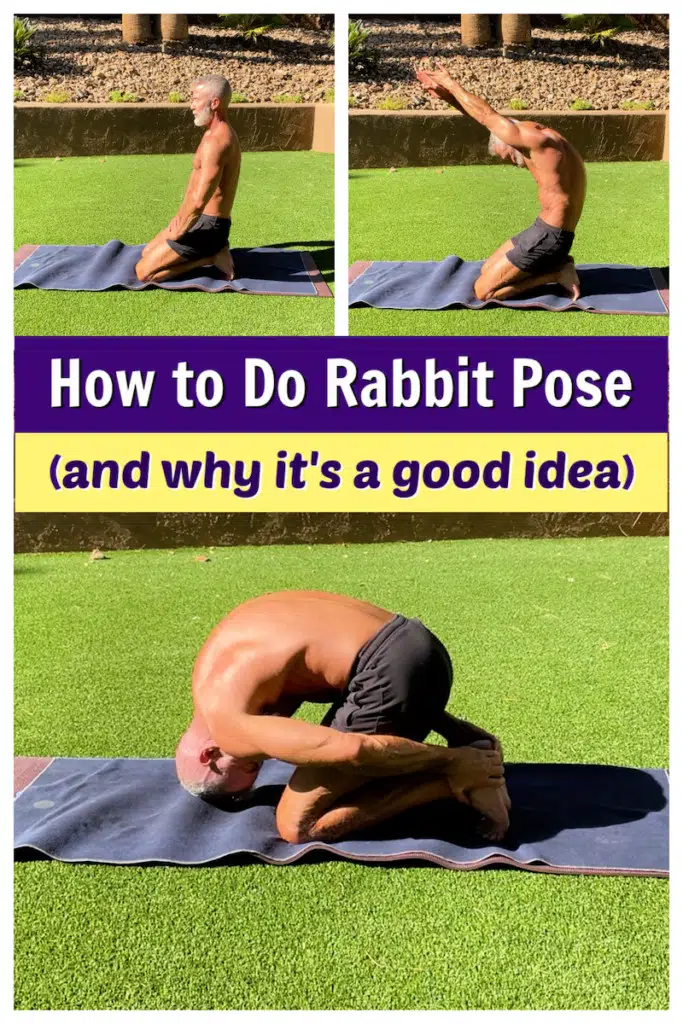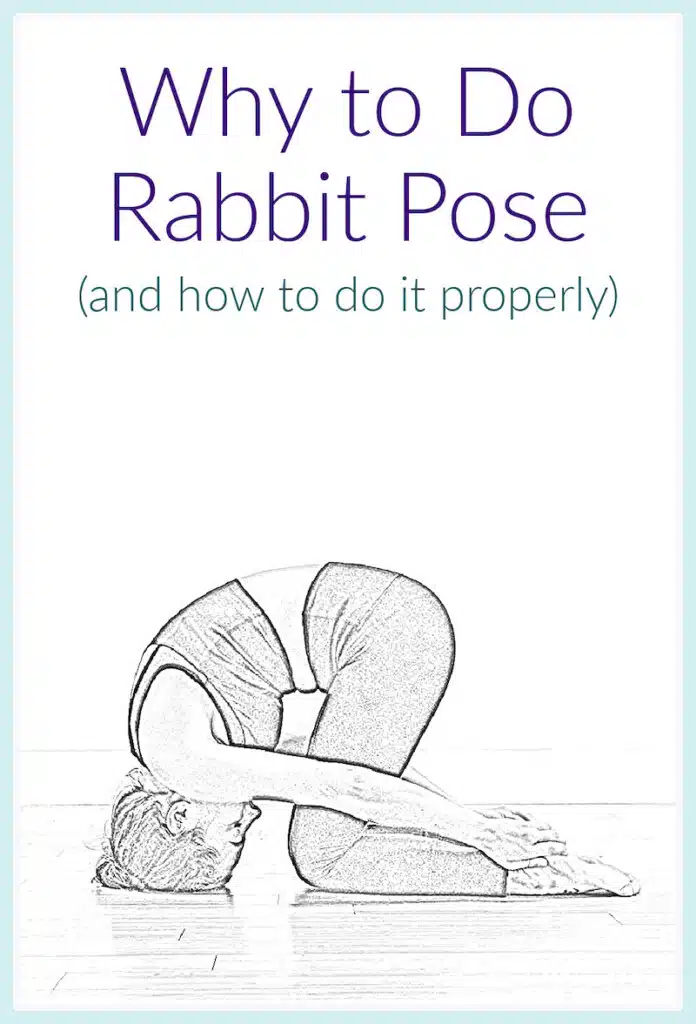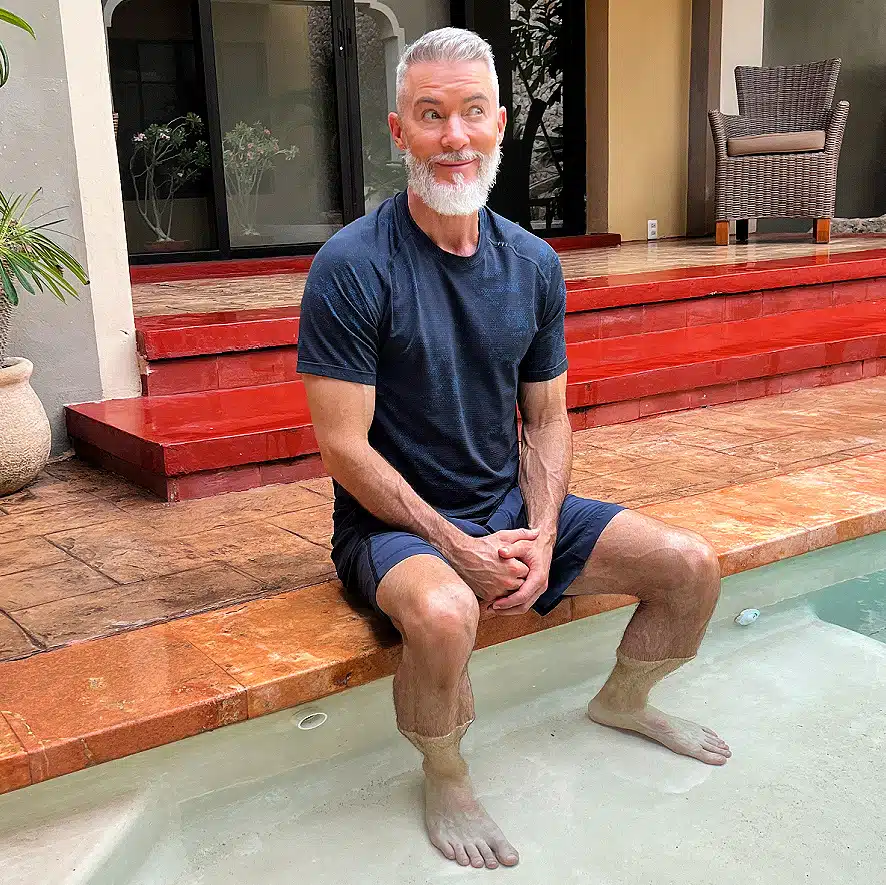Carefully alternating between backbends and forward bends within a yoga practice can help you create a healthier, more supple spine. Among the forward bends, the pinnacle is the rabbit pose.
As you get older, your spine can get stiff and immobile. The yoga rabbit pose will help keep your spine strong and flexible.
What follows are tips for how to do the yoga rabbit pose optimally.
Refer to the video located lower within this article to see how the pose appears in action from its start to its finish.
How to Receive the Benefits of Rabbit Pose
The rabbit pose appears subtle to the uninitiated observer.
But what the pose lacks in visual drama, it makes up for in depth of feeling.
Yoga teachers often skip this pose in class, and that’s a shame because rabbit improves core strength and the body’s overall mobility.
When done correctly, the rabbit pose helps your body feel reorganized, centered, and flexible.
The rabbit pose can help to improve your posture and create length in your spine.

It doesn’t require a lot of strength to do the rabbit pose, but it does require a high degree of mindfulness.
In particular:
- the abdominal muscles need to be intensely activated;
- a tension of opposites must be engaged, with energy running both vertically and horizontally simultaneously;
- the neck must remain fully relaxed and long without supporting any weight.
Rabbit Pose Comes from Yoga
Rabbit pose, also known as Sasangasana or Hare pose, involves getting into a position that resembles a rabbit.
The rabbit pose comes from yoga. Yoga is a physical, mental, and spiritual discipline that originated in ancient India. It involves a series of physical postures, breathing techniques, and meditation practices that are designed to improve flexibility, strength, and relaxation.
The ultimate goal of yoga is to achieve a state of physical and mental well-being, as well as a sense of inner peace and unity with the universe.
Yoga can be practiced by people of all ages and fitness levels. It has a wide range of benefits for the body and mind – including stress reduction, improved flexibility, increased strength and endurance, and improved mental clarity and focus.
How to Do Rabbit Pose
To get into rabbit pose:
- Start by kneeling on the floor with your knees hip-width apart.
- Then, lower your hips back onto your heels and reach your arms back to grab your heels.
- Lean forward and tuck your head under your arms, bringing your forehead to your knees.
- Hold the pose for a few deep breaths before releasing and returning to a seated position.
Rabbit pose is often used as a counterpose to camel pose, and it is thought to help stretch the spine and improve flexibility in the back and neck. It is also believed to help improve digestion and stimulate the thyroid gland.

As with any yoga pose, it’s important to listen to your body and only go as far as is comfortable for you.
If you are new to yoga or have any physical limitations, it’s wise to consult a qualified instructor before practicing this pose.
Engaging the Abs During Rabbit Pose
The movement of your spine curving up to the sky is initiated by the contraction of your abdominal muscles.
In particular, your lower abdominal plate – located above your public bone but below your navel – should be pulled in hard, even as you continue to breathe.
Deploying Principles of Traction During Rabit Pose
Rabbit pose is, in essence, a sustained pull.
You use focused intention to create energetic force in strategic directions – by pulling your abdominals up to the ceiling assertively while also using your arms to lengthen your spine horizontally along the ground.
In this sense, you are lengthening and shortening at the same time.
Creating Length for the Cervical Vertebrae Over 50
A common mistake during the rabbit pose is to sink too much pressure onto the top of the head.
There’s a temptation to fully rest the crown of your head onto the ground during rabbit. Resist this temptation.
If you were to relax the top of your head onto the floor thoroughly, your neck effectively would become a column supporting your body weight, and that defeats the purpose of the rabbit pose.
You want to lengthen your neck, not compress it.
Therefore, the crown of your head should hover a fraction of an inch off the floor.
Your head may appear to be touching the floor, but your neck is not pushing down into the ground. This way, your inter-vertebral disks still have plenty of room.
Where Rabbit Pose Occurs During Your Yoga Sequence
Yoga has been in practice for thousands of years, and during that period, many styles of yoga have been developed and evolved.
Rabbit pose (which also goes by the Sanskrit name sasangasana) typically occurs nearer the end of your yoga practice, when your lower back might begin to feel a bit compressed:
- In Moda Yoga, rabbit often occurs directly after the pigeon pose.
- In Bikram Yoga, the pose usually occurs after the camel pose.
Other preparatory poses for rabbit include sun salutations, which are considered a good warm-up.
A benefit to doing rabbit nearer the end of your practice is that:
- You’re sufficiently warmed up and more fully prepared for the intensity that rabbit provides.
- After so many backbends, the rabbit pose creates length in the spine, ensuring that the lower vertebrae once again have ample room.
In a Moda Yoga sequence, a seated twist or straddled side twist will often come after rabbit.
In Bikram, a seated head-to-knee hamstring stretch will often come directly after rabbit.
The Rabbit Pose Step-by-Step in the Video
Setting up for rabbit pose is sometimes done from the child’s pose, but more optimally begins from a kneeling position with flexed feet:
- Before doing anything else, take a deep, slow, breath inhalation as you lengthen your spine – imagining the top of your head floating up to the sky.
- As you slowly exhale, reach your hands back and grab your heels.

- Slowly relax your chin down as you roll the spine down – all the while grabbing your heels and pulling. (Again, the roll-down begins from the very top of your spine and gradually works its way down. Try to feel each vertebra as it releases, one by one.)
- You’re pulling your chest toward your heels as you pull your heels toward your chest, and your navel pulls up-up-up to the sky.
- Breathe deeply and slowly, imagining the air filling up the area between your shoulder blades.
- For a full minute, continue to hold and breathe and create that traction.
- To release, start at the base of your spine and gradually roll those vertebrae back up.
- Release the grip of your heels and lay your hands – palms up – on your thighs and give your body a few moments to integrate the benefits of the rabbit pose before you move on to another pose.
In the video above, you might notice that I make two atypical adjustments beforehand:
- I use my hands to help separate my toes a little wider from one another. This gives me a firmer foundation from which to enter the pose.
- I do a vacuum pose first. This helps me to focus on my core and achieve that hollowed-out sensation before entering the rabbit pose.
Other Benefits of Rabbit Yoga Pose
Science has established yoga as beneficial to overall health; however, more research still needs to be done to validate the benefits of the individual poses themselves.
Rabbit has been reputed anecdotally to improve blood flow, the parathyroid glands, the endocrine systems – including hormone imbalances – the nervous system, the immune system, and the elasticity of the spine.
Rabbit Pose Considerations for those Over 50
If you happen to be over the age of 50, there might be some modifications necessary for you to enjoy the rabbit pose safely and effectively.
Firstly, it’s wise to consult your medical doctor before making any radical changes to your movement patterns.
Secondly, though poses sometimes involve approaching the edge of discomfort, an actual sensation of pain is never a good idea during yoga practice.
The way to do any yoga pose optimally is to proceed cautiously and modify each pose to accommodate the unique needs of your own body:
- Though rabbit is usually performed with knees together, if doing the pose that way causes tenderness in your kneecaps, you might instead safely experiment with knees a few inches apart.
- If your toes are too stiff and inflexible to do the pose with flexed feet, you might experiment with feet pointed and relaxed.
- You can also put an extra folded blanket or towel under your knees for extra cushioning if that feels better.
The Bottom Line on Yoga’s Rabbit Pose
As you do activities that increase your awareness – such as yoga – you’re improving your attention to all sensations within your body – and that means you’ll become better at avoiding accidents, making better decisions, and taking better care of yourself in general. Yoga bolsters this type of mind-body connection.
Many yoga practitioners believe they experience significant benefits from doing yoga consistently, including developing their spinal flexibility, improving strength and joint mobility, and reducing lower back discomfort. If it’s true that yoga can lessen inflammation within the body, then that also means that yoga helps alleviate chronic disease.
I encourage you to experiment with consistent yoga practice – including the rabbit pose – in a way that honors your own age and the unique circumstances and limitations of your physique. Begin gently at first; you can always make your practice more challenging as you continue along your yoga journey.
Additional Sources on the Discipline of Body Postures:
Synopsis of 50 Scientific Yoga Studies – https://www.vox.com/2015/7/22/9012075/yoga-health-benefits-exercise-science
Yoga Statistics – https://yogaearth.com/yoga-research/yoga-statistics/
Psychological Health Effects of Mindfulness – https://www.ncbi.nlm.nih.gov/pmc/articles/PMC3679190/
